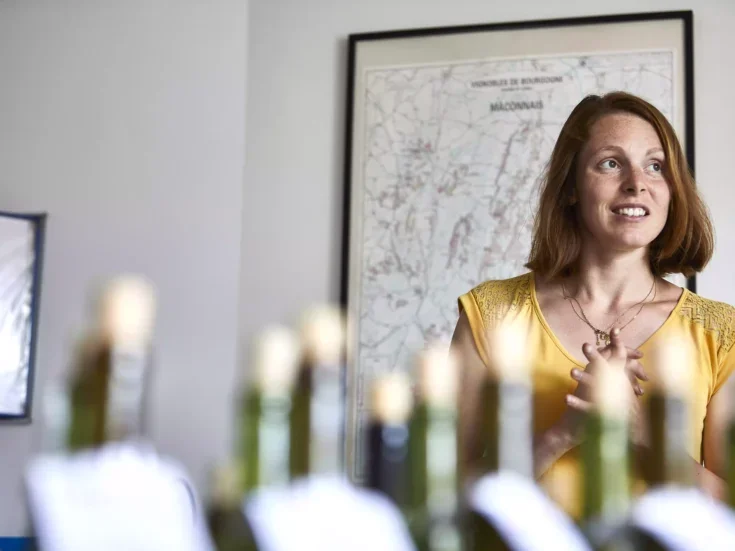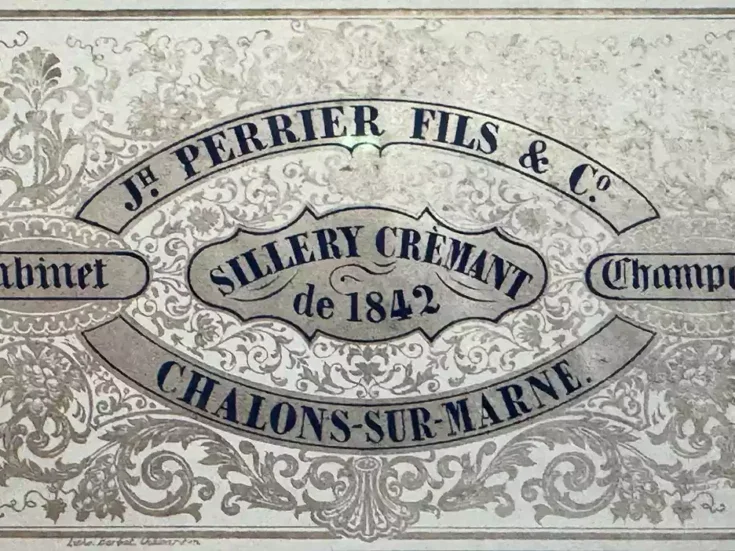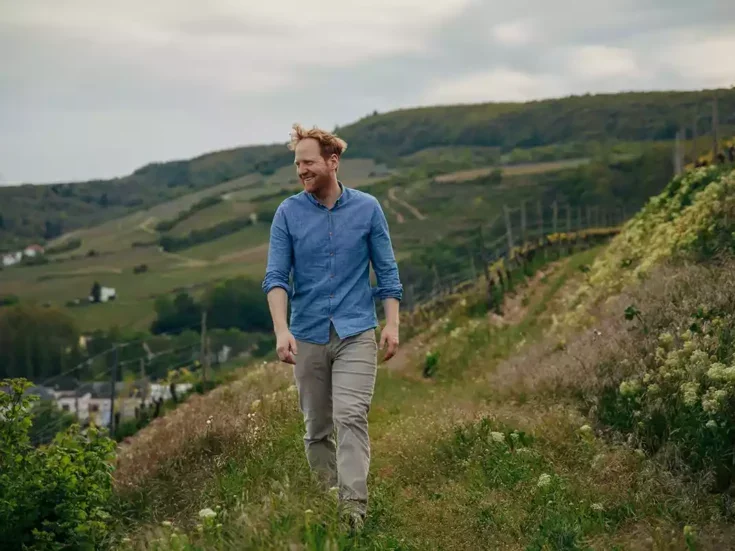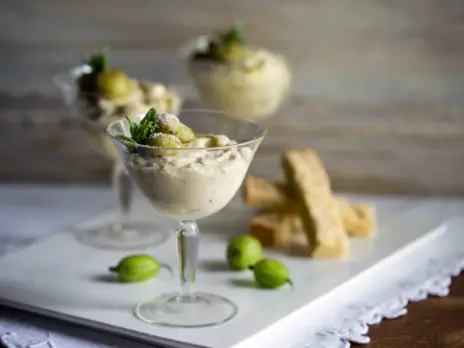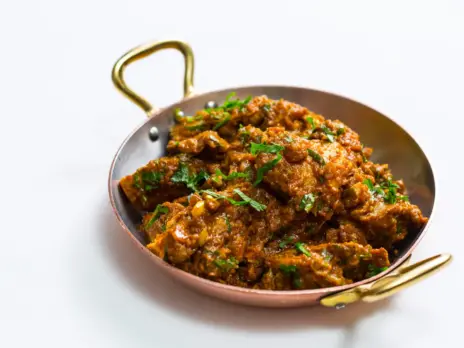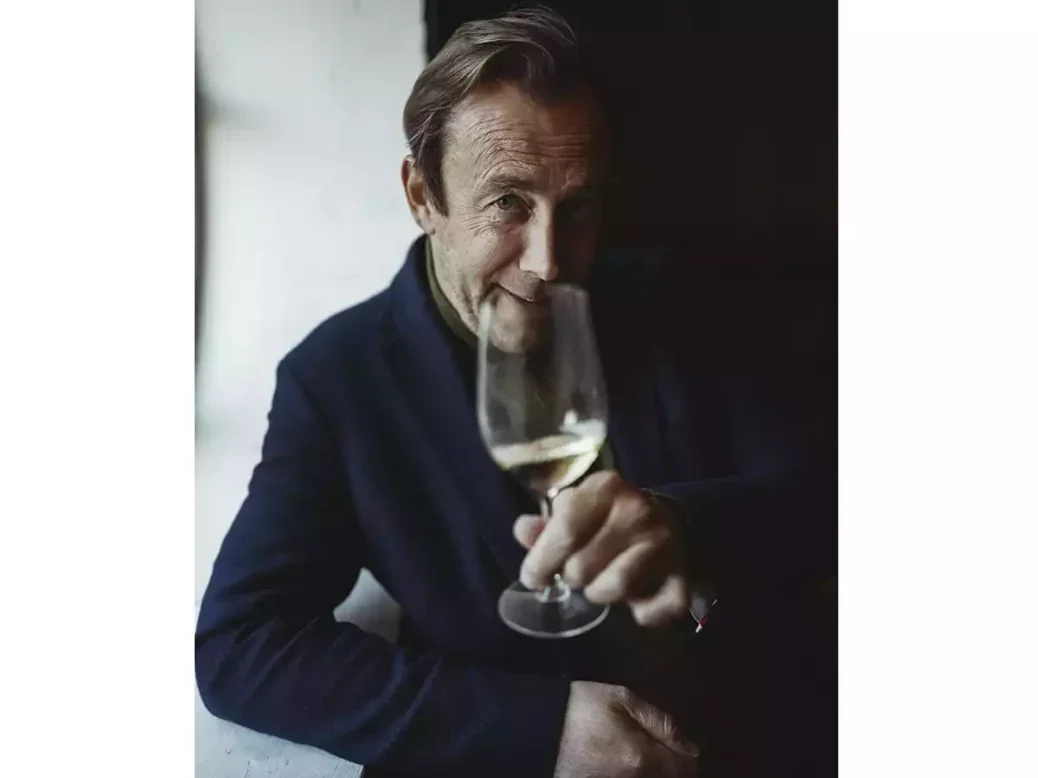
It was only the second masterclass Olivier Collin had ever given in the UK, and just like the first, five years ago, it was held at Noble Rot in Lamb’s Conduit Street, London (see WFW 68, pp.84–87). The audience was chiefly made up of sommeliers from across the country, representing a total of 23 Michelin stars between them. Collin emphasized how important the “gastronomic channel” was for his “gastronomic wines,” with only small proportions of his already limited production allocated for selected retail.
Destiny
Collin briefly summarized his career, noting that he returned to his home estate after law studies in 2003, to the village of Congy in the Val du Petit Morin. This Champenois subregion is tucked to the southwest of the Côte des Blancs and north of the Sézannais, where his parents had rented out both cellar and winery to a big Champagne brand, selling their grapes. “I was passionate about Burgundy and thought this was a pity,” Collin explained, so he decided to create his own Champagne estate, which he named after his forebear Ulysse. He initially kept the grapes from the Les Pierrières parcel in the 2004 vintage to make his first wine. “In my mind, I wanted to produce special wines from Champagne, as in Burgundy, because I am dedicated to single-vineyard production,” he said, noting that initially no site was written on the label. “That was because we needed time.” The way the vines had been cultivated had been “a disaster,” he said. “So, I began to plow, to change the way of the vines. At the time, this was a revolution in Champagne, when growers took their own destiny.” He also chose to vinify all his wines in wood. “We decided on alcoholic fermentation with natural yeast, without filtration,” he said. He presented six wines and delved into their history and composition but also revealed some key themes of his winemaking philosophy.
Clear goals
First comes farming. “We have a small team, but I work with great professionals,” said Collin. “It is important for me that people understand what they do—from the plowing, to the picking of the grapes. We are a team of five, but we are all professionals. We have essential people with us, and without them it would be impossible to produce Champagnes like these.” He stressed that “medium yields” are important and that he wants “to achieve natural concentration from low-vigor vines.” Then comes the harvest point: “We never look for overripeness, we just look for ripeness—something that becomes more and more difficult. The challenge is to keep the balance, the freshness, and the detail.”
Selection is paramount. His estate has 8.7ha (21.5 acres) of vines, but he produces wine from only the best 6ha (15 acres), the fruit from the remaining 2.7ha (6.5 acres) being sold, as Collin frankly stated, “to have money and the ability to progress.”
On winemaking and style, Collin’s key statement was that he wanted “evolution without oxidation.” To this end, he said, the juice goes into barrel, becomes wine, and stays there until bottling. Reserve wines are kept in casks or foudres with thicker staves, especially Pinot Noir, which he thinks is more “fragile” than Chardonnay.
Dosage—which should be “the balance of the wine”—is always kept between 0.85g/l and 2.4g/l, so all the wines are extra-brut. Collin insists on rectified, concentrated grape must for the dosage because he does not want any “extraneous sugar. It is easy to use, very precise; it is neutral and permits me to reveal the taste of each terroir.”
Aging is next—both for reserve wines and the Champagnes themselves. Collin noted the financial effort of slowly building up reserves and increasing the proportion of reserve wines in his cuvées. Likewise, the financial effort of leaving wines on lees and keeping them post-disgorgement, which takes up precious space and binds capital. He was also careful to build his wine range step by step. His first wine was Les Pierrières in 2004, then he added Les Maillons in 2006, Les Roises in 2008, Les Enfers in 2010, the Rosé from Maillons in 2011, and Jardin d’Ulysse in 2015. Les Pierrières and Les Maillons account for 70% of his production. His aim is “to produce individual and singular wines. Step by step we built and completed the range. The purpose is to go further each time.” By this, he means that he has kept aside 250 magnums each year since 2016—they are yet to be released.
Collin’s wines, unusually, have a very gentle, almost dissipating mousse. Yet he explained that he always makes his wines to have six atmospheres of pressure, as normal in Champagne, of which around one atmosphere is lost at disgorgement. But perhaps this is also a question of concentration and of temperature. Collin made a point of serving the wines at ambient temperature. Somewhat mysteriously, he added that “the idea is to find the right balance of effervescence to reveal aroma and not too much brittle acidity.”
Siren songs
Coming away from the tasting, I thought what an apt name Olivier Collin had chosen for his Champagne venture. There he was, like Ulysses, setting out on his voyage, defiantly leaving the security and comfort of immediate cash for grapes and rent for his cellar. The classic Ulysses tied himself to the mast not to heed the siren calls. I believe Olivier is another kind of Ulysses, captivated by those distant siren songs he could discern from vineyards underappreciated for centuries. Perhaps they came from the river nymphs of the Petit Morin? He made it his quest, his destiny, to create such authentic, individual, and deeply visceral wines from this almost-forgotten valley. The sirens and nymphs must love him—and his wines. He made the right decision.
Les Pierrières Blanc de Blancs, which has an average annual production of 12,000 bottles, is from a single plot of 1.3ha (3.2 acres) in Congy. Collin noted that this is his coolest site, facing east, with just 4–6in (10–15cm) of clay sitting on top of what distinguishes this vineyard: a blend of Campanian chalk mixed with flint. It is here that Collin started the slow process of gradually building up reserve wines and of slowly increasing the time each of his wines spends on lees. “We began to sell this cuvée in 2008, with 24 months of aging. We then increased to 36 months, and now we are at 48 months. Initially, it was a pure Vintage wine,” he said, adding that all reserve wines are kept in wood. The wine we tasted was based on the 2016 vintage, with reserves from 2015 and 2014. “2016 was a fantastic, cool vintage. It corresponds with this kind of wine,” Collin said.
Les Maillons, with an average annual production of 22,000–24,000 bottles, is from the eponymous 2.5ha (6-acre) plot, also east-facing, planted to Pinot Noir in the village of Barbonne Fayel in the warmer Sézannais. Here grapes usually reach a potential alcohol level of 11%. There is a 650ft (200m) difference between the bottom and the top of this sloping site, giving much “nuance” to the parcel. The soils are of deep clay, ideal for Pinot Noir, planted by Collin’s grandfather, René, in 1971 and 1972. Collin thinks of these almost-55-year-old vines as “old but not very old.” He first made a single-plot Champagne from this site in 2006. The slightly higher dosage of 2.4g/l “corresponds to the generosity of this plot,” Collin said.
Les Enfers is produced in even smaller quantities, coming from a tiny (0.6ha [1.5-acre]) east-facing site in Collin’s home village of Congy. He first made a single-site Champagne from it in 2010. Les Enfers is available with both 48 and 60 months on lees.
Les Roises, also with a very small production of just over 2,000 bottles per year, is from a site neighboring Les Enfers, and of the same size (0.6ha [1.5 acres]) but south-facing. It is planted to a massal selection of Chardonnay that is now 75 years old, yielding only 35–42hl/ha. The vines have court-noué, or fanleaf virus, which, along with their age, explains the low yields. “It is impossible to ask these vines to produce more,” Collin said, “and I want to keep them for as long as possible.” He described the fruit as “very concentrated” and the wine as “charged with sun.” Again, Collin cited his grandfather René, who planted these Chardonnay vines to the amusement of his fellow villagers: They thought this plot was predestined for Pinot Noir.
Le Jardin is a 1.55ha (4-acre) site inside the village of Congy, which Collin named d’Ulysse. It is a cold site, and 70% of it faces north. It is usually picked two weeks after Les Maillons in the Sézannais—generally only reaching 10% potential alcohol. The soil in the north-facing part is deep clay on top of chalk. Its south-facing portion has just 24in (60cm) of clay on top of chalk. It is co-planted with Pinot Noir, Pinot Meunier, and Chardonnay, and the grapes are usually co-harvested and co-pressed. The vines were planted in 1950 and in 1985; the later planting replaced vines in the coldest part of the site that died during a “black frost” with temperatures as low as –4°F (–20°C). Only the best fruit is used; the rest is sold. Production is just 3,500 bottles. Initially, Collin decided that Le Jardin d’Ulysse should spend 60 months on lees when he first made it in 2015. He remembered how difficult it was to have several years of production without knowing how the wine would turn out. “It was pure adventure,” he said. The 2015 and the 2016 vintages were sold with 60 months of lees aging, but this 2017 vintage was left on the lees for 72 months and is also special in other ways. Usually, Le Jardin d’Ulysse is a blend of one third each of Pinot Noir, Pinot Meunier, and Chardonnay, reflecting the planting proportions of this field blend. The 2017 vintage, however, is pure Chardonnay, from what Collin described as “an awful vintage,” in which heavy rain before harvest was followed by a heat spike. This caused the Pinot Meunier to rot, so it had to be discarded. The Pinot Noir could be harvested via stringent selection, but the fruit was sold because it was not up to Collin’s standard; therefore, only the Chardonnay made it into the wine that year.
The highly unusual rosé comes from 2.5ha (6 acres) of Les Maillons, from which Collin produces “a rosé de saignée in exceptional years only.” The making of this wine starts in the vineyard, where lower yields are required to achieve the necessary concentration and “to obtain the best phenolic maturity, at around 11% potential alcohol. We work differently; we prune short. We have around 65hl/ha for the blanc de noirs, but for the rosé de saignée we have 50hl/ha.” For Collin, making a rosé de saignée requires old vines and a warm plot that faces east—all three criteria met in Les Maillons, where the vines are 55 years old. In years when the wine is made, production is between 1,500 and 3,000 bottles, and it is always a Vintage wine even if this is not indicated on the label. The fruit is macerated for between 24 and 36 hours, and only free-run juice is used. While Collin decided to give it just 36 months on lees, the wine we tasted was disgorged six years ago, in March 2019, and was as fresh as a daisy. He first made it in 2011, and we tasted the 2015 vintage, which, according to Collin, “you can have with veal or with strawberries.” I would agree—it is utterly gastronomic but has all the makings of what the Italians call a vino da meditazione.
Tasting
Les Pierrières Blanc de Blancs Extra Brut NV
(100% Chardonnay; 2016 base, 50% reserve wines; 48 months on lees; disgorged March 2021; dosage 1.7g/l)
Lovely, ripe, yellow apple on the nose, wrapped in smoky mellowness, reminiscent of a just-extinguished candle, with an edge of peppery, white nougat. Tiny bubbles on the palate underline this fine line of pepper, imbued with a juiciness reminiscent of green melon, laced with lemony freshness and the exquisite frisson of pepper. Perfect concentration drills down into cool, cool chalk, again with that evocative notion of white pepper. | 96
Les Maillons Blanc de Noirs Extra Brut NV (100% Pinot Noir; 2018 base, 50% reserve wines from 2017 and 2016; 36 months on lees; disgorged March 2022; dosage 2.4g/l)
Oatmeal, smoke, red berry, and evocative smoothness define the nose like a promise of richness. Concentration is evident on the palate, where this presents a dollop-like, rich shape, with superbly smooth, gentle bubbles, on a body rounded with supple smoke, Red Delicious apple peel, and a texture gliding with exquisite waxiness that calls for food. Freshness runs like a current through this wine—impressive for a 2018 base—and presents an oatmeal-inflected, creamy, umami finish, now shining with tart rather than mellow apple and smoke. The foam dissipates and leaves a most rounded wine. | 94
Les Enfers Blanc de Blancs Extra Brut
(100% Chardonnay; 2016 base, 20% reserve wines; 60 months on lees; disgorged February 2022; dosage 2.4g/l)
An exquisite lemon note on the nose precedes creamy oatmeal—extremely enticing, direct, urgent even, with its bright, citrus verve. The body comes with surprising heft, with power, with a kind of concentrated, sinewy punch, plunging into exquisite umami depth, almost visceral, willing you to take another sip of this flavor composite that unites creamy apple flesh, smoke, the merest tantalizing whiff of bergamot, aligned to green- and yellow-apple highlights. Saltiness trails right through the creamy oatmeal texture with astonishing length and such arresting, beguiling depth, all underlining the concentration. Superb. | 97
Les Roises Blanc de Blancs
Extra Brut NV
(100% Chardonnay; 2015 base, 20% reserve wines; 60 months on lees; disgorged March 2021; dosage 2.4g/l)
The nose is a gorgeous unison of melted butter and fluid candlewax, with an edge of creamy licorice and tulip petal. More air reveals a touch of dried tangerine peel. On the palate, this has an almost unctuous flow, a smoothness and fullness. If I did not know better, I would think this was a Coteaux Champenois—it comes across much more as a still wine than as a sparkling—with just a touch of waxy apple and almond-skin bitterness. The chief sensation is waxiness. This is full, rounded, smooth, and distinct. | 95
Le Jardin d’Ulysse Extra Brut NV (100% Chardonnay; 100% 2017; 72 months on lees; disgorged February 2024; dosage 1.5g/l)
Freshly cut, tart apple flesh with green apple peel appears on the nose, along with white pepper, buttery sponge cake, and slight smoke. This is the first wine where the mousse is insistent, where its energy fills the mouth, trailing a touch of white pepper. It comes with a different energy from the other wines, with wonderful cut and exquisite brightness. | 95
Rosé de Saignée des Maillons Extra Brut NV
(100% Pinot Noir; 100% 2015; 36 months on lees; disgorged March 2019; dosage 2.4g/l)
A deep pink hue promises body from the off. The nose is all raspberry and cherry sorbet, imbued with bitter almond and an overtone of amarena cherry, haunting and smooth. The palate almost has a sense of creaminess, but with a beautiful phenolic frame, not too distant from a very light red Pinot, but with an exquisite undertow of all that is autumnal, woodland-like, profound, and evocative about Pinot Noir. This is sensuous, generous, and sinuous, and has beautiful concentration, graceful structure, absolute poise, and the gentlest mousse. | 97

